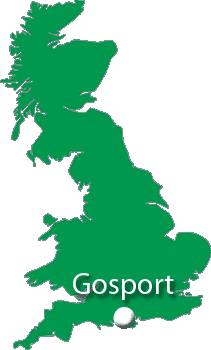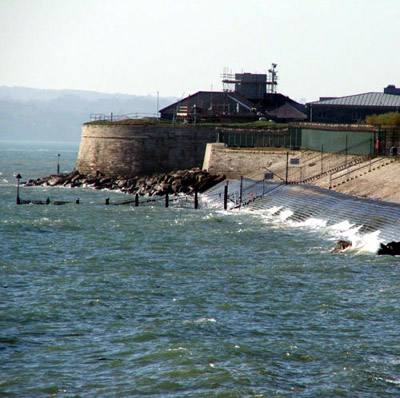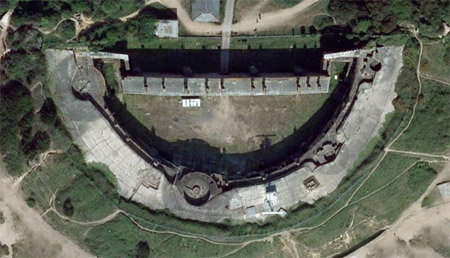 |
Fort Monckton
Gosport, UK
|
|
 |
King Henry VII (1457-1509) was the first ruler to build dry docks, which he did at Portsmouth. Henry likely didn't build these docks personally, but he was responsible for them. This feat of naval engineering occurred in 1495, and the first ship built there was Sweepstake in 1497.
As naval power became increasingly associated with Britain's raison d'être, Portsmouth developed into a bigger and bigger deal. Everyone was worried about the exposed nature of Portsmouth, right down there hanging off the bottom of the British Isles, but the first fortification to protect these priceless docks wasn't begun until a perceived naval threat was inspired by the American Revolutionary War (1775-1783).
The small town of Gosport, on the western shore of Stokes Bay, is located right at the choke point through which one must sail to get into Fareham Lake, and thus get to Portsmouth. Over the years Gosport and its environs would be the focus of a major defensive buildup, eventually supporting several individual forts...but the first was Fort Monckton.
In 1779 something charmingly named the Gilkicker Sea Mark was demolished to clear enough ground for a fort. The Governor of
|
 |
 |
|
Portsmouth, Lieutenant General Sir Robert Monckton (1726-1782), had demanded that his precious naval facility be properly defended from the scalliwag Americans (who of course had nothing even remotely approaching the naval capability to attack Portsmouth, but hey, maybe the French might take the opportunity), so the first iteration of Fort Monckton (which wasn't actually called Fort Monckton yet) was thrown together. AND it was awful. The fort's walls were made of earth and brushwood, and the garrison's mighty tents continually blew away. This first fort was so exposed that it was used as a sighting point by ships entering Portsmouth Harbor...as one might imagine, a fort would best be virtually invisible until the moment it opens fire on an approaching enemy, and not something that sailors miles out to sea would spot and ask, now what the hell d'ya suppose that is?! Robert Monckton had made his name on the other side of the Atlantic when, during the French and Indian War (1754-1763), he had led a force that captured Fort Beauséjour from the French on Nova Scotia in 1755. |

You are not getting close to Fort Monckton. This is a shot of the Dolphin Wall, so named because only a dolphin, travelling at speeds of over 300 knots, could possibly leap into the fort. |
 |
Construction of what was called The Fort at Gilkicker began in September of 1780. A variety of issues with labor, design and naming of the fort kept progress down to a snail's pace. Fortunately, Sir Robert Monckton died in 1782, which made the name choice inevitable. Fort Monckton was finally completed in 1793...and the enormous American amphibious group, waiting out in the Atlantic to pounce on Portsmouth, cursed and slunk back to its facility at Little Creek, Virginia.
By 1859, the French Navy had built itself up to numerical parity with the Royal Navy...and Napoleon III (1808-1873) was a jerk who, at any moment, might decide to finish what his uncle started and invade England. Or at least is sure seemed that way to British Prime Minister Lord Palmerston (1784-1865). Palmerston established the Royal Commission on the Defence of the United Kingdom, a body that researched the UK's preparedness to meet such a threat as an attacking French fleet. |
|
|
The Commission found that the UK was in no way ready to defend itself, and in 1860 a huge program of British fort building began. The forts that were produced during this period are known as the Palmerston Forts, and the very first structures to be built were surrounding Portsmouth. Fort Monckton was considered too small and too old to be responsible for the defense of Portsmouth, so was just re-armed with more current weaponry and forced to watch as Fort Gilkicker, the ridiculously un-starrishly shaped thing we see below, was built closeby.
|
By 1870 France had turned its attention to Prussia, plus all of the expensive guns with which the Palmerston Forts had been armed were now obsolete anyway: The pace at which military technology advanced in this period was difficult for everyone to keep up with. Fort Monckton was the location for some exciting experimentation with electric lighting in 1875, and was mostly used for training purposes.
Monckton's armament was mostly
|
 |
 Fort Gilkicker: Yawn. Fort Gilkicker: Yawn. |
|
kept up to date during the First (1914-1918) and Second (1939-1945) World Wars, with the addition of searchlights and anti-aircraft guns, but never were its guns fired in anger. After WW2, seacoast defenses such as the world had been employing for the past 400 years were pretty much determined to be obsolete, but Britain's Ministry of Defence kept Fort Monckton on its active duty list, even as the rest of the Palmerston Forts were abandoned.
Today, Fort Monckton is, maybe, MI6's primary training facility. There's a lot of information on blogs floating about that suggests such horrors as mind control experimentation going on there, as well as other suppositions that seem like the text version of 50's sci-fi movie theremin music. The one thing that does seem clear is that a lot of effort has gone into making Fort Monckton inaccessible to the casual visitor, and that its grounds are patrolled by a "uniformed but unidentified force." Cue theremin music.
|
|
|
|
|
|
 |




